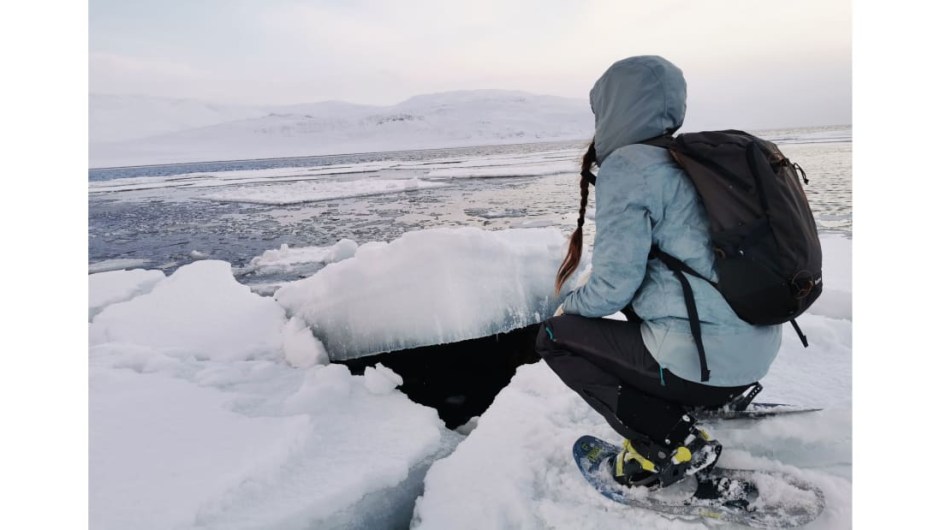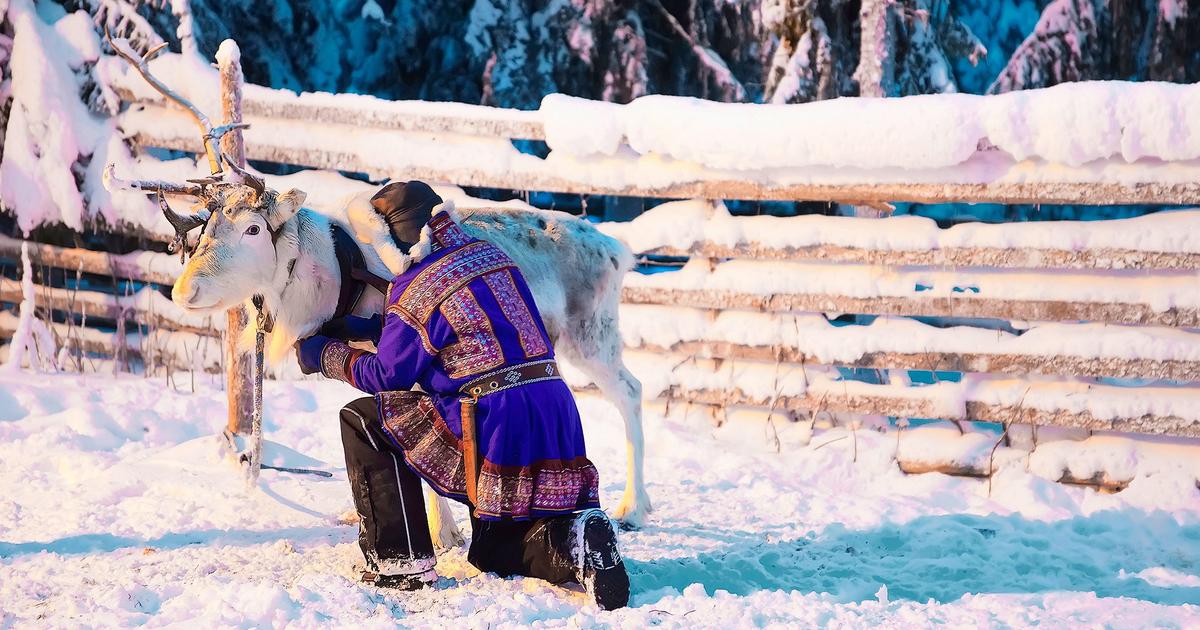1 of 18
|
Quarantine: Valentina Miozzo moved to Kongsfjord in October 2020. Photo: Valentina Miozzo / ViaggiareLibera
2 of 18
|
Freedom: The travel blogger spent eight months in the Arctic Circle.
Photo: Valentina Miozzo / ViaggiareLibera
3 of 18
|
Arctic chic: Kongsfjord houses are a far cry from those of your native Italy.
Photo: Valentina Miozzo / ViaggiareLibera
4 of 18
|
To the north: Kongsfjord is located on the northernmost coast of Norway.
Photo: Valentina Miozzo / ViaggiareLibera
5 of 18
|
Ice Queen: Miozzo had never been to Norway and had always preferred to travel to warm destinations.
Photo: Valentina Miozzo / ViaggiareLibera
6 of 18
|
Quick conversion: he loved the Arctic, he called it a different world.
Photo: Valentina Miozzo / ViaggiareLibera
7 of 18
|
Confinement: Valentina Miozzo moved to Kongsfjord in October 2020. Photo: Valentina Miozzo / ViaggiareLibera
8 of 18
|
New life: Miozzo learned to move like the locals.
Photo: Valentina Miozzo / ViaggiareLibera
9 of 18
|
Wildlife: reindeer were common.
Photo: Valentina Miozzo / ViaggiareLibera
10 of 18
|
Local: reindeer were everywhere.
Photo: Valentina Miozzo / ViaggiareLibera
11 of 18
|
Winter Weight: Seals were also a common sight on the Kongsfjord.
Photo: Valentina Miozzo / ViaggiareLibera
12 of 18
|
Teamwork: Miozzo says that the people of the Kongsfjord became a family to her.
Photo: Valentina Miozzo / ViaggiareLibera
13 of 18
|
A remote place: Kongsfjord is located right on the coast, 40 kilometers from the nearest town.
Photo: Valentina Miozzo / ViaggiareLibera
14 of 18
|
Remote work: Miozzo got used to living 321 kilometers from the nearest hospital.
Photo: Valentina Miozzo / ViaggiareLibera
15 of 18
|
Family Style: Miozzo says her bond with the 28 residents is unbreakable.
Photo: Valentina Miozzo / ViaggiareLibera
16 of 18
|
Big Melt: Now that the ice has melted, Miozzo is leaving Kongsfjord.
Photo: Valentina Miozzo / ViaggiareLibera
17 of 18
|
Virgin land: people live in harmony with nature in the tundra.
Photo: Valentina Miozzo / ViaggiareLibera
18 of 18
|
Summer style: Kongsfjord in summer looks very different than in winter.
Photo: Valentina Miozzo / ViaggiareLibera
(CNN) -
For most of us, the pandemic has meant forced loneliness.
But for others, it has been the opportunity to go find that loneliness.
And where better to do it than in the Arctic Circle?
In fact, Valentina Miozzo went one step further.
He moved to the far north of Norway - within the Arctic Circle - not just in the middle of the pandemic, but just as 24-hour polar nights were on the horizon.
It was a baptism of fire, but she liked it.
"December and January were two months of darkness," he says.
Miozzo, from the Emilia Romagna region of northern Italy, had seen her life turned upside down by the pandemic.
A nature and hiking guide, who accompanied Italians on trips abroad, also blogged about sustainable travel in Italy, and ran the popular blog Viaggiare Libera.
"Everything was focused on tourism," he says.
"My life was always spent traveling, I was away from home about six months a year."
advertising
Until the pandemic arrived.
Like many others in the travel industry, Miozzo's life came to an abrupt halt.
Unable to work, he continued blogging and doing promotional work online.
But after Italy went through one of the world's harshest lockdowns and emerged in the summer of 2020 with the virus seemingly under control, her feet started to itch again.
So when she was contacted via Instagram in September, with an offer to go to the Arctic Circle to run a guest house, she barely blinked.
"I was afraid?
No, I saw it as a beautiful opportunity to visit places that I might never have chosen on my own, ”he says.
"As I could no longer do my travel work, this was a way of traveling and experiencing another reality, in a more static way, of course, but in a part of the world that I did not know and that fascinated me."
In two days, she had accepted;
a month later, he reached Kongsfjord, about 3,862 kilometers north of his old home near Modena in Italy.
The differences cannot be greater.
Modena is a city of 185,000 inhabitants known for its gastronomy, Michelin-starred food (Massimo Bottura is based there) and the 12th century cathedral.
Kongsfjord, on the other hand, has only 28 inhabitants and has no medieval architecture.
"The closest supermarket is 40 kilometers away," says Miozzo.
"The closest hospital is almost 321 kilometers away and the airport, obviously small and local, is 64 kilometers away."
"In winter, there were 120 km / h winds and ice everywhere, making it difficult to move."
Residents venture to the grocery store every one to two weeks, as long as the roads are clear.
The route to the airport and the supermarket in Berlevåg is a winding coastal road, lined with cliffs;
in bad weather, it is impassable.
Dark nights, very dark
Valentina Miozzo moved to Kongsfjord in October 2020. Photo: Valentina Miozzo / ViaggiareLibera
"I had no expectations, I did not create them on purpose, as I was curious to find out," he says.
However, he did have an idea of what awaited him: 'I knew I was going to a very, very isolated place, I had been warned.
I knew it was extreme and I knew I was in the arctic tundra, but I had never been to Norway. '
"Shortly after my arrival, the polar nights arrived."
However, ready for anything, she was not disturbed by the darkness 24 hours a day, 7 days a week.
“It was an incredible experience, living two months completely in the dark.
It was not disturbing, in fact, it is more difficult to live with the light.
Yes, that 24/7 sunlight.
From mid-May to mid-July, Kongsfjord is bathed in the midnight sun.
"There is no sunset for two months and the body does not accept that it is night when the sun rises, so it is more difficult to sleep," he says.
But other than that, it's not annoying;
in fact, it is a beautiful way of life.
In fact, he says the extreme weather taught him something extremely important.
“When I went to hot countries, you take energy from abroad, from others, from the climate, from the atmosphere.
You are interacting with other people and there is the sun.
«When you find yourself in a place like this, completely isolated, what you learn to do is find energy in yourself.
And it is an amazing discovery, especially when there is no light for two months and you need to wake up.
Intercultural Kongsfjord
The houses in Kongsfjord are far from being those of his native Italy.
Photo: Valentina Miozzo / ViaggiareLibera
So what kind of people choose to live such an extreme way of life?
Miozzo calls Kongsfjord's population of 28 "multicultural," with Germans, Latvians, Italians and Thais living together with locals and communicating in English.
"They were all very welcoming and charming to me," he says.
He especially bonded with another Italian woman who works at the B&B, Eugenia, and says that despite Kongsfjord's cosmopolitan population, some things did not change.
“Maybe it's a stereotype that Italians tend to be much louder and gesticulate when we speak, and they don't.
I definitely noticed [a difference in] our communication style.
A place unlike any other
Miozzo says that the people of the Kongsfjord became a family to her.
Photo: Valentina Miozzo / ViaggiareLibera
It is not the first time that Miozzo has spent long periods abroad;
spent three years in London 18 years ago.
But more recently, it has focused on warmer climates, spending three months in India, Indonesia and Senegal, as well as a year in Southeast Asia.
Which makes his decision to go to the Arctic even more surprising.
But she says it's impossible to compare the Arctic to anywhere else, because it's just not like anywhere else.
In fact, he says that the north of Norway is a different world from the south of the country.
“The weather, the light, the dark, everything is different.
Here, it is a real tundra.
The trees don't grow, it's a really wild landscape.
We have red and arctic foxes and reindeer everywhere.
“There are whales, dolphins, killer whales and many seabirds;
It is known for its bird watching.
And there are seals, which are beautiful.
I have not lived in Norway.
I have lived in the arctic tundra.
The tundra was also covid-19 free.
There has not yet been a single case of COVID-19 in Kongsfjord, and although Norwegian cities were under restrictions, the extreme isolation in the village meant that life could continue normally.
"I didn't wear a mask for seven months," says Miozzo.
Reopening
Kongsfjord in summer looks very different than in winter.
Photo: Valentina Miozzo / ViaggiareLibera
The opening of travel as the pandemic is under control worries Miozzo.
"Before the pandemic there was a kind of tourism linked to exhibitionism, and its presence on social networks," he says.
“You needed to prove that you are abroad, so you would take a selfie with a tiger or an indigenous person.
Traveling was losing its meaning as an instrument of personal growth, of self-discovery.
«And physical distancing has to do with fear, not only of being infected, but also of infecting.
So it will definitely influence the interactions we will have with people in a place now.
Things like hugging are part of normal human interaction so we will do less of it and try another way of communicating and transmitting our interest in another culture.
"It will definitely change the way we travel, but we will have to see exactly how."
As a sustainable travel blogger, she has been driving "slow" tourism since 2007, and she hopes that another side effect of the pandemic will be that we take longer and move more slowly when traveling.
And he believes that the way we view nature and outdoor tourism could change.
“We should be more aware of how powerful nature is now that we have seen it in the pandemic, and that should make us think of humans as an integral part of nature, not as something to go see as a museum, or just use, ”she says.
Rather, we should be in contact with it, respect it, preserve it.
Save her.
Arctic life forever?
Miozzo learned to move like the locals.
Photo: Valentina Miozzo / ViaggiareLibera
Miozzo's official stint at the guesthouse ended two months ago, but his time in the Arctic made such an impression that he stayed in Kongsfjord, renting a house instead.
"It was beautiful being here," he says.
But now he is preparing to leave, at least temporarily.
It's not that I'm going back to Italy.
Instead, he bought a car together with Eugenia, and they head north to the ultra-remote Svalbard Archipelago, the northernmost inhabited settlement on the planet year-round, located just 1,046 kilometers below the North Pole, where humans share the streets with polar bears
After a month traveling there, they will head south to the Lofoten Islands, where they will work in another guesthouse.
And after that?
“I have created beautiful relationships and solidarity with the people of Kongsfjord;
It is as if we have created a family, now I am linked to them, so I will definitely return in the future to visit them, ”she says.
For the fall, he sees his guiding work return, so he's thinking of going back to Italy.
Although as she says it, it sounds ripped.
"Actually, I don't know, anything could happen," he says.
«I chose my career for this reason: I can work while traveling.
And I have always left the doors open to what life offers me.
travel guides








/cloudfront-eu-central-1.images.arcpublishing.com/prisa/4RITWNCKAZFB3I3MBXYYKH6YDI.jpg)